Dirty and Dangerous Water Threatens Country’s Health
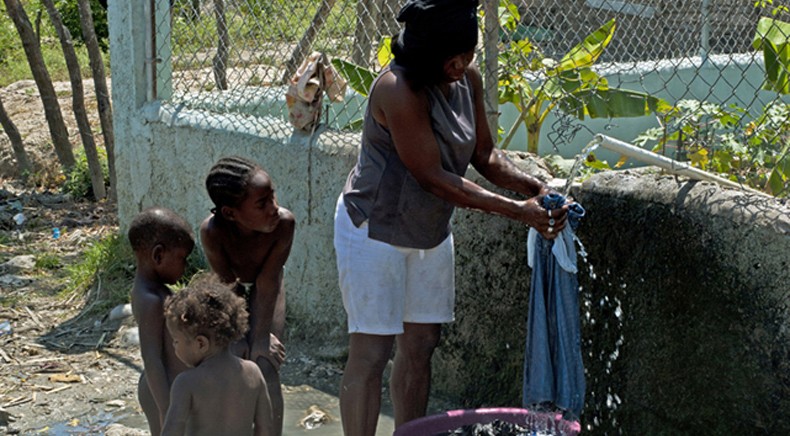
BY BASTIEN INZAURRALDE
Cronkite Borderlands Initiative
BATEY NINE, Dominican Republic – Christin Morin has to stop and think about the last time he drank water that was really clean.
It’s been a couple of months since the 54-year-old agricultural worker and his wife had a few spare pesos to buy chlorine or potable water, so they rely on water from the Batey 9 village tank. The water is free and accessible but also dirty and dangerous.
Birds sometimes get trapped in a tiny hole in the tank and die inside. When villagers turn on faucets in their homes, they may get a sickening mixture of water, feathers and dirt.
 SLIDESHOW: Clean water is available but largely unaffordable for the impoverished residents of Batey 9. |
Running water and drinkable water are not synonymous here.
“The water doesn’t receive the treatment that is needed to make it suitable for human consumption,” said David Perez Julis, mayor of the municipal district that oversees bateyes 7, 8 and 9, where nearly 700 Haitians have settled since the 2010 earthquake in their country.
“At times, some women have come to me and told me, ‘I turned the faucet on in my house to drink water and I saw small birds and water insects,’” Julis said.
Waterborne diseases – often the result of poor sanitation and lack of treated, drinkable water – that are a rarity elsewhere are common in Independencia, the poverty-stricken province where Batey 9 is located, near the border with Haiti.
Julis said the recent arrival of so many Haitian immigrants in these villages — the three bateyes have a total population of 5,000 – have made already poor sanitary conditions and the lack of access to drinkable water even worse.
“Health issues started to become more acute, as families with boys and girls arrived in not so good condition,” he said.
In addition, an outbreak of cholera Haiti in late 2010 that killed nearly 5,000 people prompted widespread concern that the disease would spread to the Dominican Republic. This year, there have been 1,681 confirmed cases of cholera and 56 deaths in the Dominican Republic as of June 18, according to the General Directorate of Epidemiology of the Dominican Ministry of Public Health.
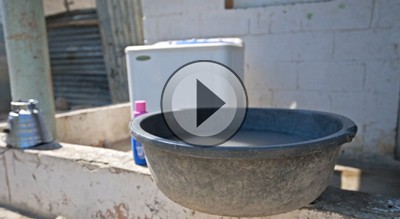
VIDEO: Drinking contaminated water can cause widespread illness and even
death. But many Dominicans have no other option. |
Those fears are most acute in border provinces such as Independencia, according to the Ministry of Public Health.
While cholera raises alarms, however, diarrhea is a much more common health problem. A nuisance in the U.S., diarrhea causes half the deaths of children under age 1 in the Dominican Republic, according to the Pan American Health Organization.
And in places like Independencia, the problems are even worse. A little more than 21 percent of children in the province contracted diarrhea over a two-week period, compared to 14.7 percent of children in the rest of the country, according to the 2007 Demographics and Health Report by the Dominican Center for Social and Demographical Studies. The mortality rate in the province was 44 deaths per 1,000 children under 5 in 2007, compared to a national rate of 36 percent, according to The Dominican National Office of Statistics.
Low levels of vaccination for common diarrheal diseases are part of the problem. Fewer than half the children in Independencia get a full series of vaccinations, according to the National Office of Statistics, and 7 percent get no vaccines at all.
The most recent child death was last year in Batey 8, when a mother settled in the community with a child who was already weak and later died of complications from diarrhea, said Beneco Enecia, former mayor of the three bateyes and head of the non-profit Center for Sustainable Development.
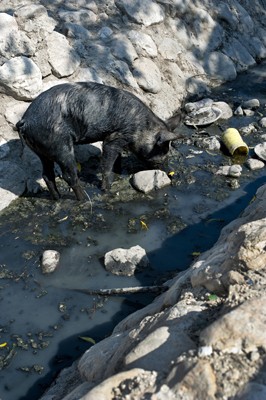
Many citizens of bateyes — immigrant communities in the Dominican Republic — have no access to clean drinking water. Photo by Lindsay Erin Lough |
Alexandra Ramirez Aquino, a nurse in Batey 8’s clinic, said impure water is responsible for most of the diarrhea in the community.
“It’s not purified or they don’t boil it. They don’t chlorinate it and the children get sick. It causes them diarrhea,” she said.
Ramirez Aquino's clinic, called a Unit of Primary Care, is a small, under-stocked building of the Dominican Ministry of Public Health that is reachable only by dirt roads. The clinic has one doctor and five nurses to serve nearly 5,000 area residents. A dermatologist comes every Tuesday, as contaminated water also causes skin problems.
Patients needing treatment that can’t be provided by the clinic are either sent to the hospital in nearby Tamayo or to a bigger health center in the neighboring province of Barahona.
Rosa-Helena Feliz, a teacher who also works as a health promoter in Batey 9, said that in addition to bringing children to the clinic, parents often bring sick children to her home, where she gives them a serum made of three spoons of sugar, a pinch of salt and a liter of clean water. She doesn't prescribe medicine because she doesn't have any.
When Feliz's nephew, 6-month-old Diego Antonio Perez Feliz, came down with a severe case of diarrhea, his mother took him to the hospital in Tamayo. The mother, Virginia Feliz Santana, said that even though she buys drinkable water for the baby, he vomited and had diarrhea for five days.
“The fever increased after three days. He was really sick; he had hard stomachache,” Feliz Santana said. “With all this happening, I felt the pressure increasing in me.”
Doctors could not tell her precisely what sickened her baby, just that “it was a virus that was around,” she said.
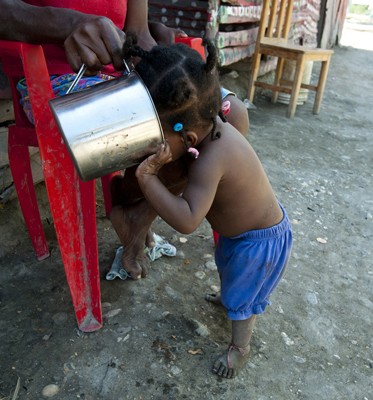
Osmila Torres, 2, drinks Coca-Cola from a cup. The drink cost 15 pesos, or about 40 cents. By comparison, five gallons of purified water from the batey’s grocery store costs 35 pesos, or about 90 cents. Photo by Lindsay Erin Lough |
Not every batey resident will go to the hospital, even if they are desperately ill. Some fear of being caught by immigration authorities at military checkpoints – there are two between the bateyes and the hospital in Tamayo, said Tomas Leyba, the head of the Red Cross in Independencia.
Most batey residents are Haitian or of Haitian descent and considered undocumented under a Dominican law that has overturned birthright citizenship. Nearly half of the population in bateyes 7, 8 and 9 is undocumented, Enecia said.
The Dominican Republic has a universal health care system that provides basic medical treatment free to all, but there are still some expenses – including medications – that some residents can’t afford.
“I was buying all the drugs. I was buying everything,” said Feliz Santana of her baby’s hospital stay.
But Enecia, whose center provides health assistance to poor residents of the bateyes, said the real issue is how to prevent illness in the first place.
“You not only get sick because you drink the (non-purified) water directly. A lot of times, it’s because it is misused after it comes out of the faucet,” said Enecia, who said water is often stored in dirty containers.
A lack of sanitary restrooms plays a part in the spread of waterborne diseases. Only one in five Independencia homes had a bathroom in 2007, according to the statistics office. Most families – 55.20 percent – had access to latrines, but 23.75 percent did not have access to any kind of toilet.
“A lot of people don’t have bathrooms or latrines . . . and they defecate outside,” Julis said. “It’s something that we’ve been trying to eradicate for several years."
Other realities, like the presence of animals and children wandering naked in the village, increase chances of diarrheal diseases as people are more likely to be in contact with excrement. The lack of plumbing in the bateyes promotes the spread of cholera, diarrhea and dengue, a mosquito-spread disease, said Miguel Carvajal, an engineer for the National Institute of Potable Water in Independencia.
Community efforts to improve the situation face numerous challenges — money being one of the biggest.
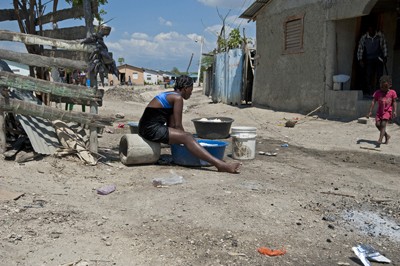
A woman washes clothes with free but untreated water from a village tank in Batey 9. The water sometimes becomes contaminated with bird feathers, dirt and other objects. Photo by Lindsay Erin Lough |
“The majority cannot buy bottled water, so we explain to them how to put drops of chlorine in a gallon of water – five drops of chlorine for a gallon of water – or how to boil it before they give it to the children,” said Ramirez Aquino, the clinic nurse.
But Batey residents often don’t follow recommendation to chlorinate water, said Carvajal. Some are plain resistant.
Dieula Blanc, a Haitian woman who moved to Batey 9 after the earthquake, refuses to chlorinate her water and simply drinks it as it comes out of the tap. Blanc is afraid that if she gets used to filtered water, she will get sick when she returns to Haiti, where she drinks from the river.
Morin, the agricultural worker, said he is used to drinking water from the batey’s tank but his wife, Jean, frequently feels sick. She has had dizzy spells, intense headaches and stomachaches for nearly five years. But they have little choice. The Morins live in a dark and decayed hut. There is no sink in their kitchen. They store water in a plastic bucket and cook with charcoal. They say they can't buy water on his income of about 200 pesos a day – about $5.20.
“A lot of times, people don’t have the 30 pesos (about 80 cents) once every two or three days to buy water,” said William Decena, pastor for a local church. That's the price charged by the water-selling truck that comes from Barahona on Tuesdays, Fridays and Sundays; a gallon at Batey 9’s grocery costs several times that much.
A new water-purifying system has been built behind the church with help from G.O. Ministries, an American nonprofit. A gallon of the church's water is less than 3 cents and 5 gallons cost 5 pesos – about 14 cents.
Yonei Feliz Cuevas, who purifies and sells the water, said a hut-by-hut educational campaign was launched to inform residents of the new system and some are taking to it. Up to 40 families a day now buy water from the new system – and Cuevas said he has had to stay at the church at night to keep water thieves away.
But not everyone is convinced. And change comes slowly here – even for the man in charge of the new water system.
On the same day that water began to be sold behind his own church, Decena bought two gallons outside Batey 9. He had forgotten that cheap, pure water was now available in his own village.


